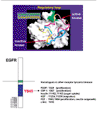Tyrosine kinase signalling in breast cancer: epidermal growth factor receptor and c-Src interactions in breast cancer
- PMID: 11250711
- PMCID: PMC138776
- DOI: 10.1186/bcr55
Tyrosine kinase signalling in breast cancer: epidermal growth factor receptor and c-Src interactions in breast cancer
Abstract
Both the non-receptor tyrosine kinase, c-Src, and members of the epidermal growth factor (EGF) receptor family are overexpressed in high percentages of human breast cancers. Because these molecules are plasma membrane-associated and involved in mitogenesis, it has been speculated that they function in concert with one another to promote breast cancer development and progression. Evidence to date supports a model wherein c-Src potentiates the survival, proliferation and tumorigenesis of EGF receptor family members, in part by associating with them. Phosphorylation of the EGF receptor by c-SRC is also critical for mitogenic signaling initiated by the EGF receptor itself, as well as by several G-protein coupled receptors (GPCRs), a cytokine receptor, and the estrogen receptor. Thus, c-Src appears to have pleiotropic effects on cancer cells by modulating the action of multiple growth-promoting receptors.
Figures



Similar articles
-
Constitutive activation of Stat3 by the Src and JAK tyrosine kinases participates in growth regulation of human breast carcinoma cells.Oncogene. 2001 May 3;20(20):2499-513. doi: 10.1038/sj.onc.1204349. Oncogene. 2001. PMID: 11420660
-
Tyrosine kinase signalling in breast cancer. Epidermal growth factor receptor: convergence point for signal integration and diversification.Breast Cancer Res. 2000;2(3):184-90. doi: 10.1186/bcr52. Epub 2000 Mar 25. Breast Cancer Res. 2000. PMID: 11250708 Free PMC article. Review.
-
ErbB receptor-induced activation of stat transcription factors is mediated by Src tyrosine kinases.J Biol Chem. 1999 Jun 11;274(24):17209-18. doi: 10.1074/jbc.274.24.17209. J Biol Chem. 1999. PMID: 10358079
-
Gbetagamma subunits mediate Src-dependent phosphorylation of the epidermal growth factor receptor. A scaffold for G protein-coupled receptor-mediated Ras activation.J Biol Chem. 1997 Feb 14;272(7):4637-44. doi: 10.1074/jbc.272.7.4637. J Biol Chem. 1997. PMID: 9020193
-
Role of c-Src tyrosine kinase in EGF-induced mitogenesis.Front Biosci. 1997 Oct 15;2:d501-18. doi: 10.2741/a208. Front Biosci. 1997. PMID: 9331427 Review.
Cited by
-
Erlotinib protects against LPS-induced endotoxicity because TLR4 needs EGFR to signal.Proc Natl Acad Sci U S A. 2015 Aug 4;112(31):9680-5. doi: 10.1073/pnas.1511794112. Epub 2015 Jul 20. Proc Natl Acad Sci U S A. 2015. PMID: 26195767 Free PMC article.
-
The role of SRC family kinases in prostate cancer.Transl Oncogenomics. 2007 Oct 14;2:67-77. Print 2007. Transl Oncogenomics. 2007. PMID: 23641146 Free PMC article. No abstract available.
-
Honokiol: a novel natural agent for cancer prevention and therapy.Curr Mol Med. 2012 Dec;12(10):1244-52. doi: 10.2174/156652412803833508. Curr Mol Med. 2012. PMID: 22834827 Free PMC article. Review.
-
Honokiol: A Review of Its Anticancer Potential and Mechanisms.Cancers (Basel). 2019 Dec 22;12(1):48. doi: 10.3390/cancers12010048. Cancers (Basel). 2019. PMID: 31877856 Free PMC article. Review.
-
Phosphorylation of Y845 on the epidermal growth factor receptor mediates binding to the mitochondrial protein cytochrome c oxidase subunit II.Mol Cell Biol. 2004 Aug;24(16):7059-71. doi: 10.1128/MCB.24.16.7059-7071.2004. Mol Cell Biol. 2004. PMID: 15282306 Free PMC article.
References
-
- Biscardi JS, Tice DA, Parsons SJ. c-Src, receptor tyrosine kinases, and human cancer. Adv Cancer Res. 1999;76:61–119. - PubMed
-
- Velu TJ, Beguinot L, Vass WC, et al. Epidermal growth factor-dependent transformation by a human EGF receptor proto-oncogene. Science. 1987;238:1408–1410. - PubMed
-
- Khazaie K, Schirrmacher V, Lichtner RB. EGF receptor in neoplasia and metastasis. Cancer Metastasis Rev. 1993;12:255–274. - PubMed
-
- Bolla M, Chedin M, Souvignet C, et al. Estimation of epidermal growth factor receptor in 177 breast cancers: correlation with prognostic factors. Breast Cancer Res Treat. 1990;16:97–102. - PubMed
-
- Toi M, Osaki A, Yamada H, Toge T. Epidermal growth factor receptor expression as a prognostic indicator in breast cancer. . Eur J Cancer. 1991;27:977–980. - PubMed
Publication types
MeSH terms
Substances
Grants and funding
LinkOut - more resources
Full Text Sources
Other Literature Sources
Medical
Research Materials
Miscellaneous

